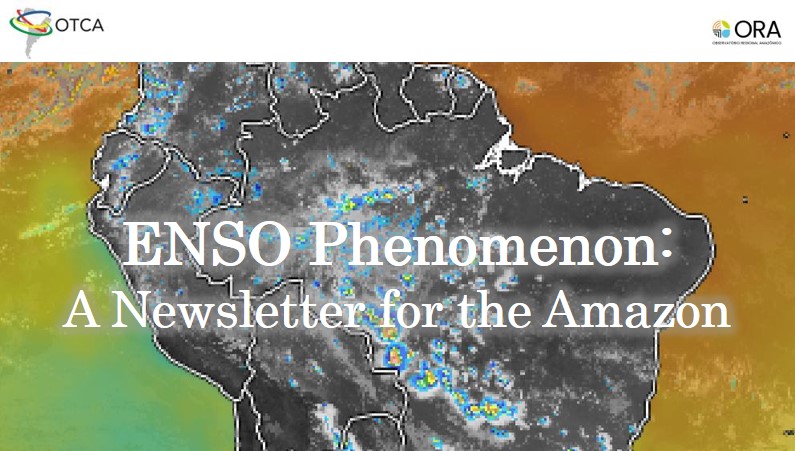ENSO Phenomenon: A Newsletter for the Amazon – December 2023

Dez, 2023 | ARO, ACTO, ENSO, El Niño, Amazon In December 2023, there was a slight decrease in sea surface temperatures (SSTs) in the equatorial Pacific Ocean. However, they persistently remained above average, signaling the ongoing presence of El Niño, particularly notable for higher anomalies in the central Pacific region. The latest Niño Index values revealed the strengthening of the El Niño, with the ocean temperature in the reference region (Niño 3) still considered very strong, and anomalies higher than 2.0°C. Forecasts from integrated ocean-atmosphere models suggest the persistence of El Niño conditions throughout the fall months (March to June) of 2024, with the peak intensity anticipated in the January to March quarter of the same year. This phenomenon is expected to influence on climate and weather conditions in the country during the upcoming quarter. The likelihood of transitioning to Neutral ENSO conditions becomes prominent, presenting a 60% chance of occurrence between April and June 2024, and maintaining this status throughout the subsequent two seasons of the forecast period. By July to September 2024, no particular category emerges as dominant, with ENSO neutral and La Niña equally probable. However, from August to October 2024, La Niña becomes the most probable category, with a 52% probability. Despite a gradual resurgence of rainfall in the Amazon region in December, anomalies in rainfall were below normal in the central, eastern, and southern parts of the region. In other western areas, including Bolivia, Peru and parts of northern Brazil, rainfall was irregular, with slightly above-average precipitation, but still below average to determine the start of the rainy season. However, the increase in flows within the Amazon River tributaries helped mitigate or eliminate navigation disruptions in the Purus, Juruá, Madeira, Solimões, and Negro rivers. The climate forecast for January-February-March 2024 points to an increased probability of below-normal rainfall, particularly affecting portions of the Amazon, notably the central, southern, and eastern regions. It’s crucial to acknowledge that climatological patterns typically designate January and February as the wettest and warmest months in the Southern Hemisphere. Given the confluence of El Niño and the elevated temperatures in the Atlantic Ocean, the situation could exacerbate, leading to drier riverbeds and the onset of extreme heat in the Amazon region, particularly in its southern and eastern expanses. You can download the ENOS Newsletter by clicking here
Read more...ENSO Phenomenon: A Newsletter for the Amazon – November 2023

Nov, 2023 | ARO, ACTO, ENSO, El Niño, Amazon During November, sea surface temperatures in the equatorial Pacific Ocean continued to above average, suggesting the persistence of El Niño. Anomalies increased in the central and east-central Pacific with the latest Niño Index values confirming the strengthening of the El Niño. The ocean temperature in the reference region (Niño 3) remained very strong, exhibiting anomalies ranging from 2.0°C to 2.5°C. Forecasts predict the persistence of the El Niño during the fall season of 2024, with a 62% probability between April and June 2024. Models also project the intensification of El Niño, with more than 55% chance of persistence between January and March 2024, and a 35% chance of becoming historically strong. Consequently, climatic and meteorological conditions in the Amazon region will be influenced by this phenomenon. Rainfall in the Amazon Region in November was not significant, resulting in belownormal rainfall anomalies in the central, eastern and southern parts of the region. In other western areas, including Bolivia, Peru and parts of northern Brazil, rainfall was irregular, with slightly above-average precipitation, but still below average to determine the start of the rainy season. The climate forecast for the next quarter (December 2023 to February 2024) suggests that rainfall estimates improved slightly, reaching normal to near-above-average values in some locations in the region during the month of December. Heavier rains are expected in the upper part of the basin, including the Andean countries of Peru and Bolivia, especially in the second week of December. However, the trend from January 2024 onwards points to significantly below-average values, especially in the central, southern and eastern Amazon region. You can download the ENOS Newsletter by clicking here
Read more...ENSO Phenomenon: A Newsletter for the Amazon – October 2023

Out, 2023 | ARO, ACTO, ENSO, El Niño, Amazon In October, sea surface temperature (SST) in the Niño 4 region recorded an average anomaly of 1.3°C, while in the Niño 3.4 region, the average anomaly was 1.6°C, indicating the persistence of a moderate-intensity El Niño. In the Niño 3 and 1+2 regions, the anomalies were 2.1°C and 2.3°C, respectively, showing a progressive intensification of the El Niño throughout the month. Forecasts from various international models indicate that by October, El Niño will be strong during the summer of 2023-2024, peaking with sea temperatures around 2°C above average. This phenomenon is expected to continue until at least the fall of 2024, with a probability of 80%. Thereafter, it is expected to weaken, possibly reaching a neutral phase in the Southern Hemisphere by the winter of 2024. These climate forecasts also suggest that, between November and March 2024, the Amazon region will experience drier conditions, especially in the eastern and northern areas. Notably, an El Niño event of this intensity can trigger significant atmospheric responses, with serious consequences for the Amazon region. You can download the ENOS Newsletter by clicking here
Read more...